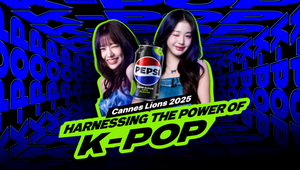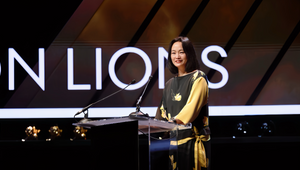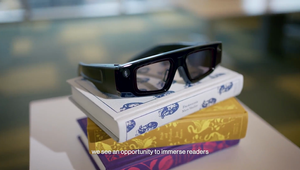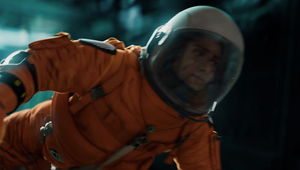
Ad Astra: Natalie Lam and the Magic of Mastery

If one were to reduce Natalie Lam’s creative philosophy to one, simple creative tip it would be this: less is more. Mastery of the fundamentals of creativity in advertising – whether that’s design or storytelling – may sound like arduous homework but it’s actually the key to creative freedom.
As a child, upon typical Asian parental pressure, Natalie would spend hours upon hours upon hours with a brush and ink, carefully and precisely copying the brushstrokes of the Chinese calligraphy masters. Like a pianist drilling scales and arpeggios, Natalie was building up muscle memory and a repertoire, only for her she was laying the foundations of form and space.
“You just practice, practice, practice. It trained me to be a very visual person, to recognise shapes and forms and really care about the little details.”
These days, Natalie’s day job doesn’t really call for penmanship per se, but that well-trained eye is fastidious and the steady, confident hand can happily whip up a sketch of an idea in moments, especially useful when the team is tussling with a problem too big and messy for words.
Sketching, for Natalie, represents a particular kind of creative freedom: the ability to make something from scratch, rather than through the curation of references.
“I still find a lot of times that when I’m brainstorming with people virtually, I have to sketch things out. It’s impossible to just use words to describe an idea or a plan,” she says. “I’m sure a lot of creative directors, ECDs still complain that no one sketches any more, they go right to Photoshop. For me, I think sketching is an important skill to have – it’s an organic part of the process of coming up with something completely from scratch.”
But back to that training. Natalie says she wasn’t so much drawn to advertising and design - rather she had a very clear idea of the sort of thing she didn’t want to do. Parental expectations that she would obligingly follow a path to law, medicine or finance were duly thwarted. Though she describes herself as a systematic thinker, the structures and systems of the corporate world held little appeal and the responsibility of holding someone’s life in her hands was far too intense. And so she flew halfway round the world from her native Hong Kong to New York.
At art school in New York, she stumbled into design, realising that it would be the perfect field for her. She recalls one summer internship at a small design studio, where she would sit in front of a huge monitor, kerning the spaces between letters with Adobe FreeHand.
“I think that type of training is actually really meditative. That makes you appreciate the important small things,” Natalie reflects. “For me, I think my approach is quite systematic that way. Once you take care of the basics, implement the fundamentals, then you can embellish. Then you can find what is the most interesting spark to build on top of a very strong foundation. That’s the way I operate.”
These days the idea of spending hours on end kerning is probably akin to some sort of ancient artisanal craft, as platforms like InDesign and Canva do ever more of the heavy lifting with artificial intelligence. Times change, but there is still something frustrating about the fact that many creatives’ arsenal these days lacks the basics. Even if one isn’t a designer, there are certain fundamentals of advertising and of human behaviour that are core, regardless of specialism.
“I do get upset and frustrated when those – in my mind – very important fundamentals are missing. If you look at Picasso, he was very, very good at what he did before he evolved into abstracting and breaking all the conventions,” says Natalie, who says that you need to know why the rules are in place before you break them. “That’s my school of thinking, and I think that’s also because I started with design where I learned that ‘everything is planned for a reason’. I bring the same approach to advertising; I like to know the principles of how the world operates, how businesses run, what are the fundamental drivers in humanity, the human insights and therefore, how do you build on that.”
Precision and detail only fed one side of Natalie’s creative soul. Within the careful designer there was a big-thinking creative director bursting to get out. The first inkling of this came in her first job out of art school, where she would design annual reports for Fortune 500 companies. Sure, laying out the numbers so they were crisp and legible was an important part of the job, given that it was public information… but the start of the report required storytelling. Painting an upbeat picture, presenting a believable but investable vision for shareholders.
At R/GA, where Natalie worked for the likes of Nike, she’d look over at the pure creative shops that R/GA shared its clients with. Wieden + Kennedy or Crispin, Porter + Bogusky would dig out the insight and set out the overarching strategy and big idea, while Natalie and her team would build out the digital ecosystem.
“I was very jealous of that. I wanted to be doing that instead of being told ‘make this’, so that’s where I started getting into the agency world and making the switch,” she says.
And so the agency world beckoned and Natalie found herself working for the likes of McCann, Ogilvy and more – with a pitstop as an ECD at Google. And that ability to switch between the micro and the macro, the planned and spontaneous proved to be the ultimate skill for navigating adland.
Natalie reflects that it’s a little like cooking. And having all of those skills and all of that knowledge baked into her subconscious frees her up to play without having to second guess herself. “I love, love, love making things. I love improvising. Knowing the ingredients, the conditions I’m working with, knowing the end goal and putting it all together. So, for example, with cooking, I’m always switching back and forth. Sometimes I’m a planner, sometimes I hate planning. Sometimes I just open the fridge and see what’s there and improvise something.”
In 2021 Natalie joined Publicis Groupe as the chief creative officer for Asia Pacific, Middle East and Africa. With such a diverse area under her eye she found herself both leaning into the granular details that emerge in different markets and teams while also tapping into the transcendent universals. Of course, the fact she joined when much of the region was still under some sort of covid-19 related lockdown meant that she had to make those connections remotely at first, but since then she’s found getting to know the nuances of each team and culture extremely enriching.
“I definitely learned, being in such a diverse region, that it’s not one size fits all. There are all these little nuances that you need to respect and observe and see what motivates people,” says Natalie. “I think it’s about finding the common things that connect us all. Why are we doing this? What makes you excited? What is the satisfaction of the job? I find it more or less the same, that drive for amazing work.
“Of course the definition of amazing and how to get there is very different from team to team, from region to region, from culture to culture. But once you find that common thread it’s much easier, so you speak the same language.”
Speaking with Natalie, it’s clear that she gets a lot of inspiration and energy from working with the teams around her regions, whether it’s the talented teams in Lebanon, where female creatives have taken the lead with outspoken and stylishly confrontational work on women’s rights, or India, which she finds has a flair for comedy. A case in point is Leo Burnett India’s Spotify campaign that leaned into the idea that music can get you out of the most mundane or annoying situations.
Since she’s joined the network, the Asia Pacific, Middle East and Africa regions have produced some real standout campaigns. For starters, there’s the ambitious multi-year platform for insurance company Suncorp in which Leo Burnett Australia is pushing to make Australia ‘more resilient’ in the face of growing incidences of extreme climate emergencies and wildfires. If they achieve their goal, it should help save lives and homes while also stopping insurance premiums from becoming unaffordably high. One House to Save Many won the Innovation Lions Grand Prix in 2022.
This year, Leo Burnett Taiwan also impressed Natalie with their work for Ronald McDonald House, McDonald’s charity. The move to paperless receipts has made it harder for charities in Taiwan to raise money by collecting shop receipts, which enter you into a government-run lottery. In response, the team alighted on the solution of creating beautifully designed phone wallpapers with a barcode that, when scanned, allowed shoppers to donate their lottery entry.
“Every single network talks about business transformation, digital transformation and no one ever expects a traditional creative agency to take on that job. But I thought that it’s really brilliant for a classic creative agency to do it. They have true gen-z creatives, they don’t think ‘am I doing an ad, or am I solving a problem or am I doing mobile?; The insight and solution comes so naturally to them,” says Natalie. “I love that nimbleness, I love how real it is.”
“Every single network talks about business transformation, digital transformation and no one ever expects a traditional creative agency to take on that job. But I thought that it’s really brilliant for a classic creative agency to do it. They have true gen-z creatives, they don’t think ‘am I doing an ad, or am I solving a problem, or am I doing mobile?’ The insight and solution comes so naturally to them,” says Natalie. “I love that nimbleness, I love how real it is.”
Another campaign that Natalie really admires, from Publicis Groupe and Saatchi & Saatchi UAE, is 2022’s ‘Empty Plates’. The activation was a Ramadan campaign designed to raise money for the poor and hungry – tapping into wealthy Dubai residents’ love of unique car number plates, the team auctioned off some unique ‘empty’ car number plates. From Natalie’s perspective, the whole project encapsulates one of her favourite design approaches.
“It’s a classic creative approach. I’m a big fan of minimalism. The power of absence rather than always piling on more. The ultra-simplicity becomes a message,” she says. “That’s great – but I think what’s amazing is the actual impact when I heard that they raised 40+ million USD because of this idea. That for me is the power of creativity.”
Indeed, minimalism is a mantra for Natalie – she generously shares her admiration for the Cannes Grand Prix-winning British Airways outdoor work from British agency Uncommon. And minimalism is, she ponders, a sign that one has trust in their craft. A less sophisticated client would have pushed to fill the white space with more messages and images. “It’s just minimalism. You don’t need anything more, less is more. I think it takes really strong design fundamentals to make work like this, which unfortunately is increasingly lost in our craft today.
“Like food in Italy, “she continues. “If you go on vacation to a beautiful small town, you just need the freshest ingredients. You need a really amazing tomato with a few drops of great olive oil. That’s it. You don’t need more than that. When you have a strong, strong, strong foundation, you know that it works already. Then the rest of your job is about how to give it a spark and make sure it stands out.”
That confident minimalism also informs Natalie’s approach to technology. She has a clear-eyed focus and a strong trust in the tech experts she works with at Publicis Groupe that she avoids becoming lost in the swirling excess of platforms and technologies out there. Neither does she feel the need to throw every buzzy new bauble at a campaign – it’s about simply choosing the right technology for a given project.
“I’m someone who always thinks that a tool is a tool. It helps serve a human purpose, so it’s the purpose that comes first, then you pick the best tool,” explains Natalie. “Of course, the best tools change over time, but I’m not overwhelmed. We have some amazing creative tech experts at Publicis Groupe who I often check in with. I’ll say, alright, what’s the ultimate goal? And if I must use this, then tell me what I need to know.”
Even in her downtime, Natalie is drawn to the minimal approach. Her favourite movies to watch used to be what she describes as ‘very slow, European, quiet films’.
“I have a thing for French movies where, for whatever reason, everyone always runs a gallery and they have a lot of little human dramas,” she says. I think they take me out of my immediate work challenges and deadlines and all of that and it brings you to a very different world for two hours,” she says.
These days, she only really gets a chance to watch films when she flies. Lately she has enjoyed the Penelope Cruz movie ‘L'immensità’, a tale of a mother in 1960s Italy, supporting her child who wishes to transition. Or ‘Living’, an adaptation of Kurosawa’s ‘Ikiru’, starring Bill Nighy as a bureaucrat facing a cancer diagnosis. And there’s the ponderous Irish meditation on loneliness, friendship, and creative ambition, ‘The Banshees of Inisherin’. What unites such movies is the focus on seemingly small scale, very human dramas, stripped bare and free from the distracting spectacle of explosions and CG imagery. When simple stories are done well, ponders Natalie, they’re never simple.
“These films tend not to have any special effects or big dramatic music, it’s just pure good storytelling and acting and casting and imperfect-looking people. It’s a good escape. Sometimes what we do has so many layers and is over produced. Purity is important.”
In a world where we’re ‘always on’, where information overload threatens to undermine our attention spans, this centred, focused, and confident clarity is an increasingly rare trait. It’s something that didn’t necessarily come naturally to Natalie. It’s a muscle. And with every careful brushstroke, every meticulous piece of typography and every deeply-considered campaign that muscle has grown ever stronger.
If one were to reduce Natalie Lam’s creative philosophy to one, simple creative tip it would be this: less is more, but do it brilliantly.
This piece was updated on 01/11/23















